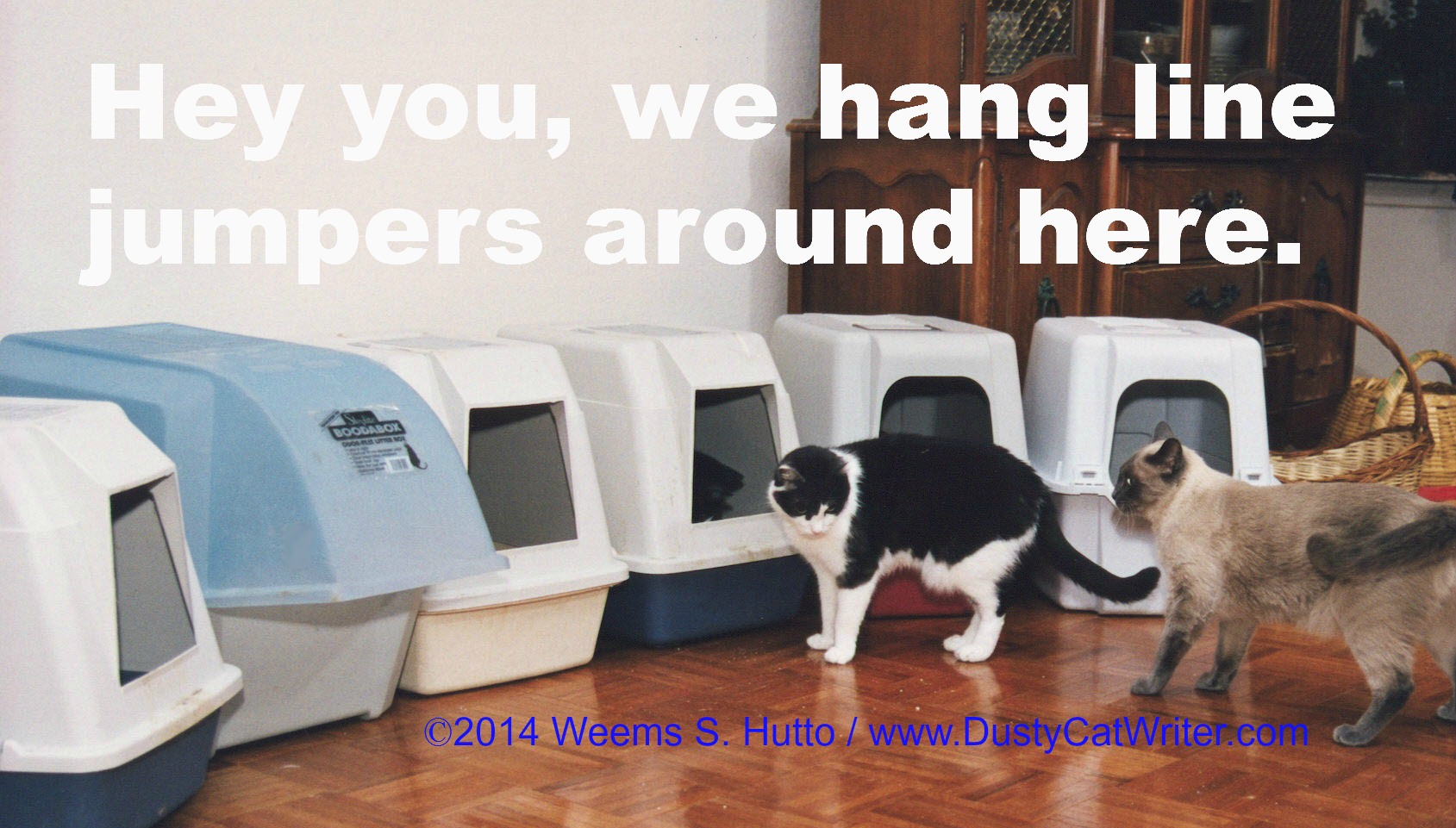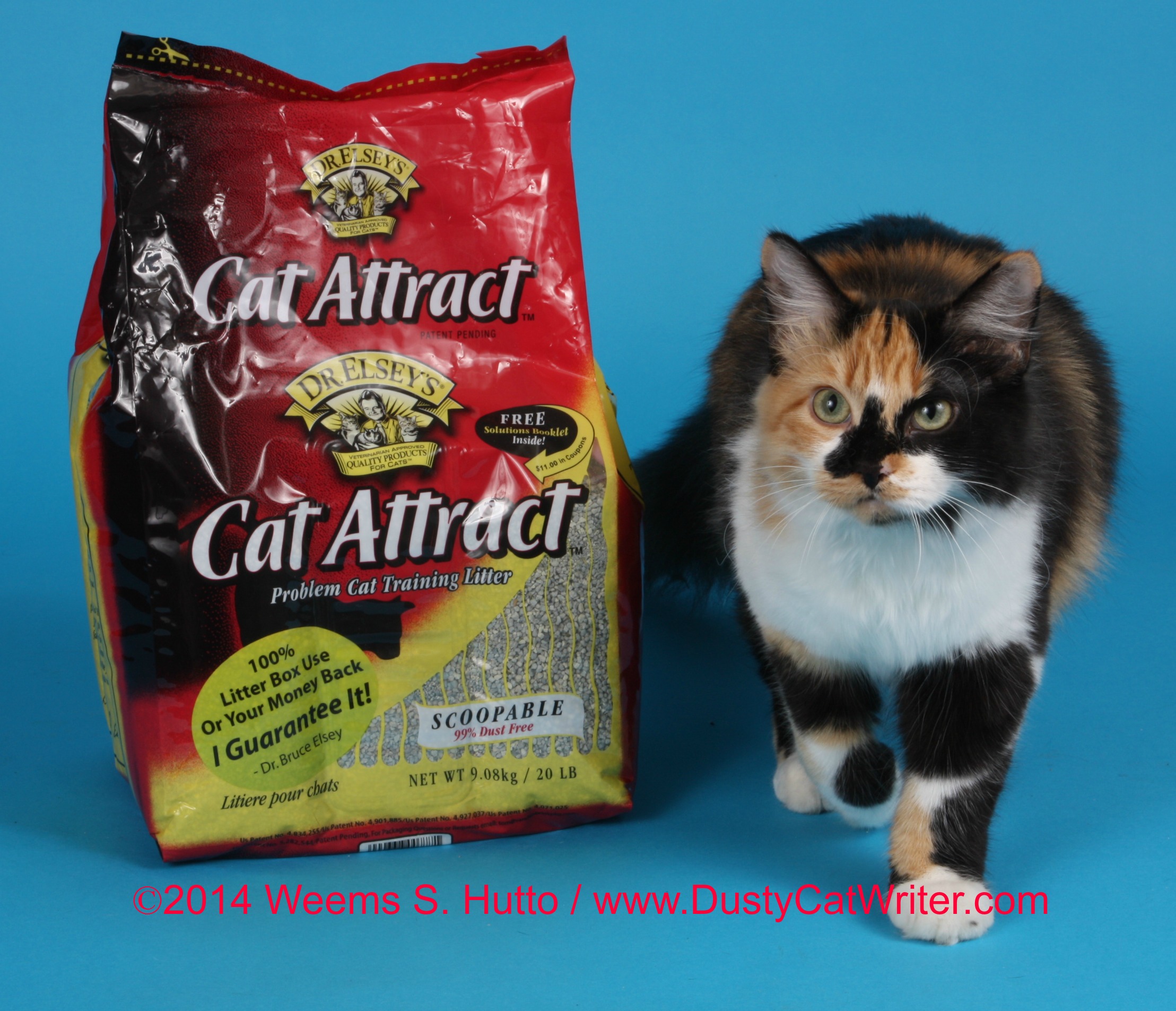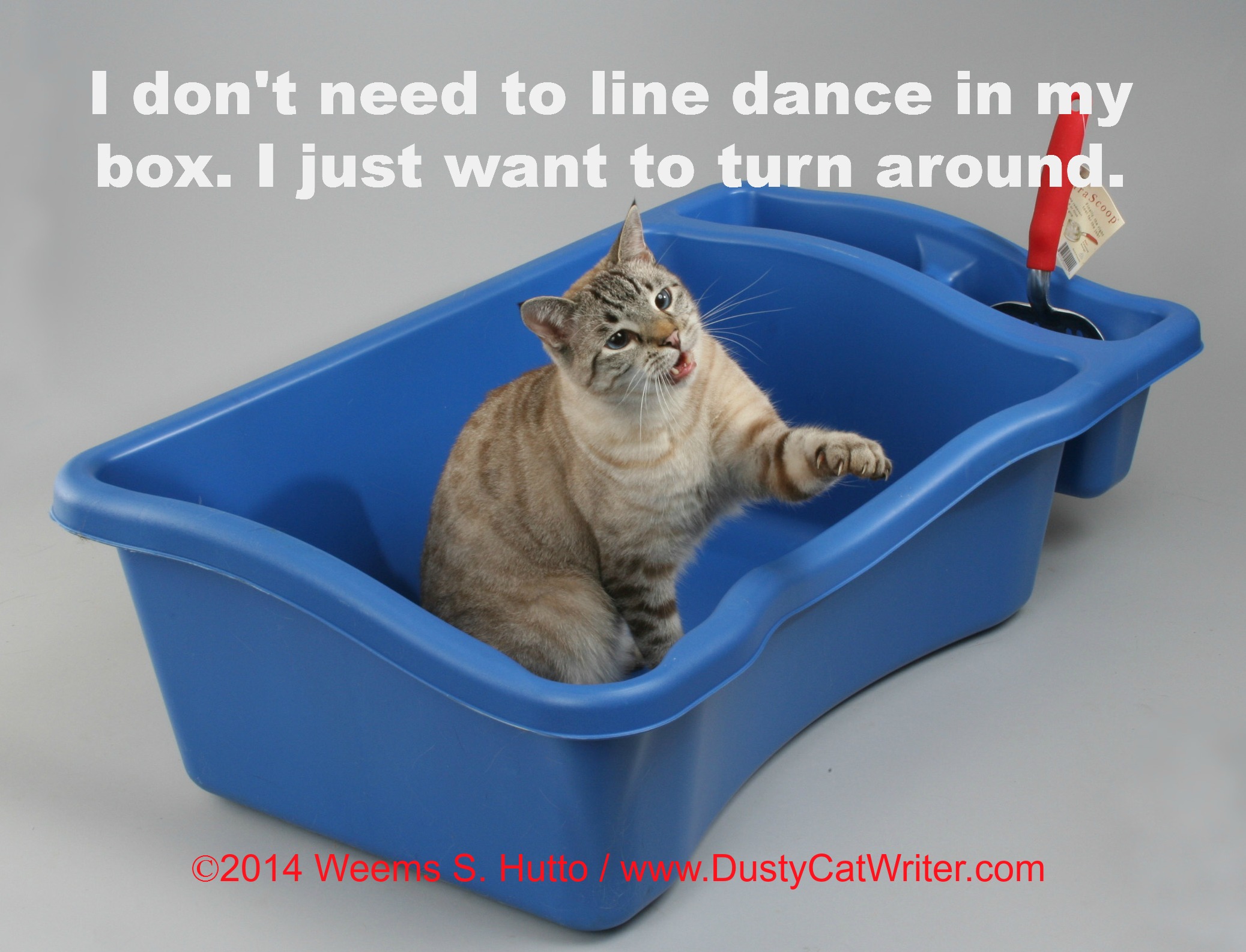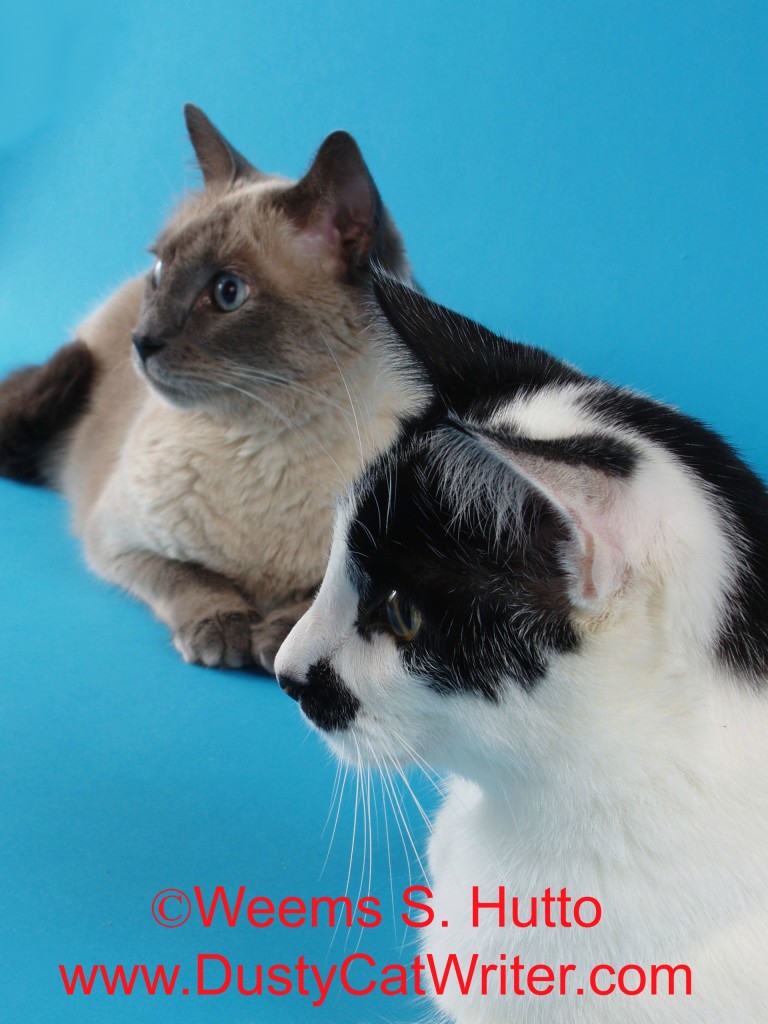 A couple of times a month I get a call from someone who’s “moving” in a few days and wants me to take her 10-year-old cat. Where, pray tell, did they get my number? From a cousin’s friend’s yoga teacher? I suspect it’s actually written inside bathroom stalls at nearby Petcos.
A couple of times a month I get a call from someone who’s “moving” in a few days and wants me to take her 10-year-old cat. Where, pray tell, did they get my number? From a cousin’s friend’s yoga teacher? I suspect it’s actually written inside bathroom stalls at nearby Petcos.
Since I only foster cats who are on animal shelter Death Row, I try to help with advice and resource recommendations. After some quizzing, I frequently learn the future homeless cat is peeing outside the box, the most common behavioral excuse given for surrendering a cat.
First of all, if a well-mannered cat suddenly stops using his box, go to the vet. Often litter box avoidance is the first symptom that your cat is sick. How else can he say, “I feel like dog poop”? He’s literally writing his distress in the sand, or rather outside the sand. Even if Fluffy has been anointing the carpet for a while, it could still be a symptom of cystitis, arthritis or even life-threatening conditions like diabetes, thyroid disease or kidney disease. Never assume he’s doing it to spite you.
I always take the owner through a checklist when discussing litter box issues:
- How old is the cat?
- How many cats do you have?
- How many litter boxes are there?
- How big is the box?
- Where is the box located?
- How often do you scoop?
- What kind of litter do you use?
It never ceases to amaze me that people with spotless bathrooms expect their cats to use a small, unscooped covered box saturated with enough ammonia to curdle coffee.
On many occasions I’ve fostered shelter cats labeled “Inappropriate Eliminators”. Two of them had terminal illnesses. (If only their people had taken them to the vet when the problem first began.) Most of my feline guests appropriately deposit eliminations in the quarantine room litter box. (Please note: the kitty gets a large open litter box that’s scooped twice a day and filled with Dr. Elsey’s Cat Attract™.) These cats aren’t habitual offenders; their compliance confirms that they were the one who had been offended. Often the responsibility for litter box transgressions lands firmly at human feet.
 Dr. Bruce Elsey, DVM, owner of the first cats-only practice in the Denver Metro area, frequently heard clients complain about their cats missing the litter box.
Dr. Bruce Elsey, DVM, owner of the first cats-only practice in the Denver Metro area, frequently heard clients complain about their cats missing the litter box.
“If you can’t work with the cats and get them over these litter issues, many of them end up at shelters or are abandoned,” Dr. Elsey says.
This tragic and all-too-frequent outcome inspired him to develop a litter that would encourage kitties to use the box. He tested various versions on cats at his clinic and local shelters and came up with Dr. Elsey’s Cat Attract™.
I discovered the litter in 2003 during my 14 years as the product editor/reviewer for the Tufts University newsletter, Catnip. Using the techniques recommended by Dr. Peter Borchelt who (as far as I know) conducted the first cat litter preference studies in the early 1990s, I set up what I called the Poopsy Challenge. I offered the Rainbolt
Test Kitties all of the most popular cat box fillers (including the brand new Dr. Elsey’s Cat Attract™) in identical new side-by-side litter boxes.
During these preference tests, I scooped several times a day and recorded the number of pee clumps and poops. At the time of this evaluation, my household was experiencing the Great Litter Box Rebellion of 2003, occurring after the Great Duck Food Raid. Whether the sampling of duck pellets contributed to the epidemic of feline cystitis, we never determined. Whatever the cause, the Test Kitties were peeing everywhere; and I mean everywhere.
According to my original review, my culinarily curious kitties were watering the most unusual places—the couch, the stove, my desk; to these little bladders, nothing was sacred.
Once my vet and I got the corporate bladder health under control, we had hoped the kitties would return to their former sanitary habits. That didn’t happen.
But the product review must go on, and I laid out my traditional litter box testing configuration. I couldn’t believe my nose. MY little offenders started using the Dr. Elsey’s Cat Attract™ in significant numbers, displaying an obvious preference over all the other litters. OMG! The proprietary herbal blend really did act as a cat attractant.
From that day on my kitties have always had boxes filled with Cat Attract. And whenever I get those calls from frustrated families, I immediately recommend a vet visit and switching to Dr. Elsey’s litter.
Dr. Elsey offered some excellent advice for frustrated cat owners that I have paraphrased.
 Dr. Elsey’s Rules to Keep Kitty Using His Litter Box
Dr. Elsey’s Rules to Keep Kitty Using His Litter Box
Scoop daily. Twice is better. (Hey, you expect the person ahead of you to flush. Your cat wants the same courtesy.)
Size Matters. The litter box should measure one-and-one-half-times the cat’s length so he can easily turn around in it. Most commercially available litter boxes aren’t nearly large enough.
In a multiple cat home, the rule is “a box for every cat, plus one”. If you live with three cats, you need at least four boxes.
Diamonds are forever, but plastic litter boxes aren’t. Polypropylene litter pans develop microscopic scratches that trap bacteria and odor. Eventually the plastic capture odors that can’t be washed away so dump the old box in the recycle bin and buy a new one.
Location, location, location. Placing the box next to a washing machine, dryer or furnace that can scare the pee out of a kitty answering nature’s call. Also make sure there is a box on every floor of the home. Your 10-year-old kitty might not be able to make it upstairs or down to the basement in time.
Provide an open box. Enclosed boxes are too small and hold in odors.
Check out Dr. Elsey’s free brochure Litter Box Solutions.

Most cats don’t like scents. Switch to an unscented litter with a fine, sandy texture.
After scooping the box take a quick sniff. If the scooped litter still smells musty or you detect ammonia, it’s time to wash the box and refill with fresh filler.
Offer a box with lower side to older kitties. Arthritis makes getting into and out of boxes a painful event for senior kitties.
Privacy please! Make sure kids and other pets aren’t harassing kitties while they are using the box.
Disclaimer: This post is sponsored by Precious Cat on behalf of the BlogPaws Blogger Network. Dusty Rainbolt’s Universe is being compensated for spreading the word about Precious Cat’s Cat Attract formula, but rest assured, I only write about products my cats love and use regularly. Paying me to write about inappropriate elimination and Dr. Elsey’s Cat Attract is like paying me to eat chocolate. I’m going to do it anyway, but kitty needs a new pair of shoes (or rather a new collar.) Precious Cat is not responsible for the content of this article.










What a great testimonial: truthful, educational and witty. What amazes me how humans don’t use their nose more. If we can detect any litter box odor, imagine what a cat can with their superior sense of smell.
Such a good point, Layla. Their noses are so much more sensitive than ours.
Great post, Dusty. Interesting story about the cats raiding the duck food and ending up with urinary issues. You offer lots of good advice about caring for the litter box too. I love the photos. The first one gave me a laugh with its caption.
Thank you.
Great article dusty exactly what I always tell everyone who calls me to ask LAP to take their cat for that reason, except I have just been saying cat Attract litter r there two different brands of cat attract litter?
Thanks Sondra. You’re right. Dr. Elsey makes several Attract litters. Senior Attract (which is my very favorite), Kitten (which is great for kitties with sensitive claws, Longhair (because cats with paw fur don’t like clumping litter.) There’s also the silica gel Respiratory Relief that I recommend if the kitty or the human has respiratory issues. I wish Senior Attract came in 40 pound containers like the original Cat Attract.
. Hey everyone. This lady was my cat rescue mentor. Sondra, thank you for all you taught me when I got into rescue in 1986 with that original litter